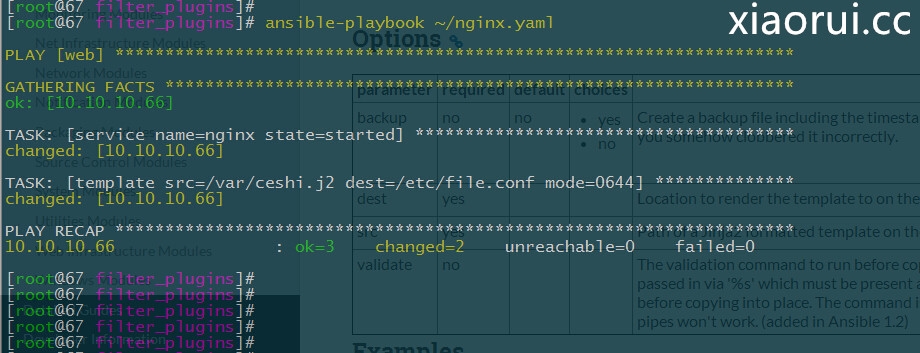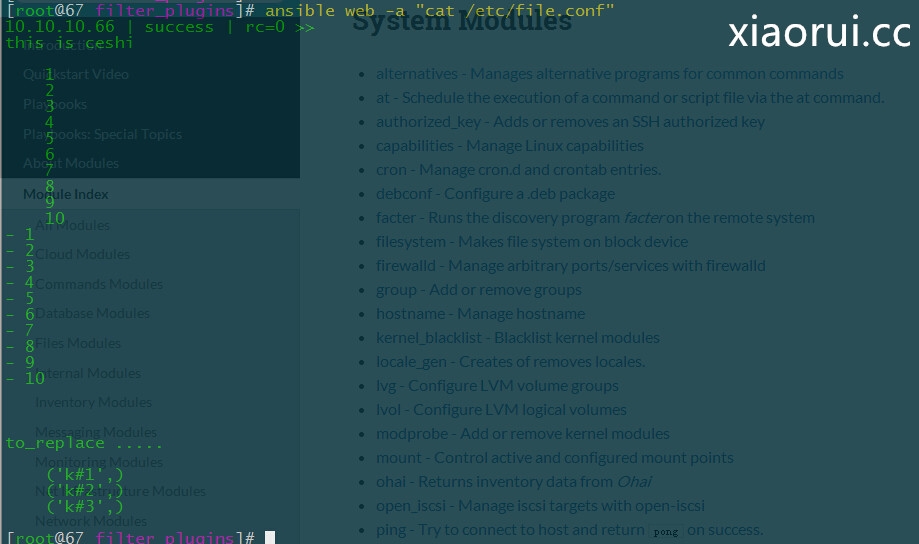首页 > 代码库 > ansible filter_plugins插件实现jinja2自定义filter过滤器
ansible filter_plugins插件实现jinja2自定义filter过滤器
前言:
filter_plugins是什么? 这个单词拆解下,filter ! 熟悉jinja2模板的人,到知道他是过滤器,可以在模板中以管道的方式用pyhton的代码处理字符串。 ansible模板调用的是jinja2,这个大家都知道 。 这个filter_plugins插件代码,就是为了更好的处理jinja2模板中的字符串和逻辑判断的。 先前,我和沈灿讨论一个模板的问题,实在蛋疼的要命,总是达不到我们要的数据,当时是做一个数据的统计和rabbitmq的配置,有些地方用jinja2模板自身的语法,处理起来实在是费劲, 用了多级{% set %}和各种length 。 其实一开始我就想用jinja2的filter,结果没看到相应的文档说明。 原来还计划着,在纠结下ansible template的代码,把jinja2的过滤器搞进去,要是不成功,自己外置一个api做处理。 看来,ansible那帮人,把能想到的东西都给做了。
这两天又看了下文档,发现讲插件的list里面有个filter_plugins,然后看了下说明,果然是他 !
原文: http://rfyiamcool.blog.51cto.com/1030776/1440686
ansible支持jinja2中默认的内置过滤器用法的,这些是一部分 ! 具体的每个功能我就不详细说了,大家自己测测就知道用途了。
abs(number)
绝对值
attr(obj, name)
属性
{{ my_variable|default(‘my_variable is not defined‘) }}
如果没有值,可以定义默认的
{% for item in mydict|dictsort %}
sort the dict by key, case insensitive
{% for item in mydict|dictsort(true) %}
sort the dict by key, case sensitive
{% for item in mydict|dictsort(false, ‘value‘) %}
sort the dict by key, case insensitive, sorted
normally and ordered by value.
escape(s)
安全的代码模式
first(seq)
第一个
float(value, default=0.0)
浮点型
forceescape(value)
强制html转义
indent(s, width=4, indentfirst=False)
{{ mytext|indent(2, true) }}
{{ [1, 2, 3]|join(‘|‘) }}
-> 1|2|3
{{ [1, 2, 3]|join }}
-> 123
{{ users|join(‘, ‘, attribute=‘username‘) }}
last(seq)
Return the last item of a sequence.
length(object)
Return the number of items of a sequence or mapping.
lower(s)
Convert a value to lowercase.
random(seq)
Return a random item from the sequence.
reject()
Filters a sequence of objects by appying a test to the object and rejecting the ones with the test succeeding.
Example usage:
{{ numbers|reject("odd") }}
New in version 2.7.
rejectattr()
Filters a sequence of objects by appying a test to an attribute of an object or the attribute and rejecting the ones with the test succeeding.
{{ users|rejectattr("is_active") }}
{{ users|rejectattr("email", "none") }}
New in version 2.7.
replace(s, old, new, count=None)
{{ "Hello World"|replace("Hello", "Goodbye") }}
-> Goodbye World
{{ "aaaaargh"|replace("a", "d‘oh, ", 2) }}
-> d‘oh, d‘oh, aaargh
round(value, precision=0, method=‘common‘)
{{ 42.55|round }}
-> 43.0
{{ 42.55|round(1, ‘floor‘) }}
-> 42.5
Note that even if rounded to 0 precision, a float is returned. If you need a real integer, pipe it through int:
{{ 42.55|round|int }}
-> 43
safe(value)
Mark the value as safe which means that in an environment with automatic escaping enabled this variable will not be escaped.
select()
Filters a sequence of objects by appying a test to the object and only selecting the ones with the test succeeding.
Example usage:
{{ numbers|select("odd") }}
{{ numbers|select("odd") }}
New in version 2.7.
selectattr()
Example usage:
{{ users|selectattr("is_active") }}
{{ users|selectattr("email", "none") }}
{% for item in iterable|sort %}
...
{% endfor %}
It is also possible to sort by an attribute (for example to sort by the date of an object) by specifying the attribute parameter:
{% for item in iterable|sort(attribute=‘date‘) %}
...
{% endfor %}
Changed in version 2.6: The attribute parameter was added.
string(object)
Make a string unicode if it isn’t already. That way a markup string is not converted back to unicode.
upper(s)
Convert a value to uppercase.
urlencode(value)
Escape strings for use in URLs (uses UTF-8 encoding). It accepts both dictionaries and regular strings as well as pairwise iterables.
wordcount(s)
个数下面是实现自定义的jinja2 filter的代码。 里面已经实现了调用ansible的template的时候,有可能会用到的filter过滤器。
原文: http://rfyiamcool.blog.51cto.com/1030776/1440686
#xiaorui.cc
import base64
import json
import os.path
import yaml
import types
import pipes
import glob
import re
import operator as py_operator
from ansible import errors
from ansible.utils import md5s
from distutils.version import LooseVersion, StrictVersion
from random import SystemRandom
from jinja2.filters import environmentfilter
def to_nice_yaml(*a, **kw):
‘‘‘Make verbose, human readable yaml‘‘‘
return yaml.safe_dump(*a, indent=4, allow_unicode=True, default_flow_style=False, **kw)
def to_json(a, *args, **kw):
‘‘‘ Convert the value to JSON ‘‘‘
return json.dumps(a, *args, **kw)
def to_nice_json(a, *args, **kw):
‘‘‘Make verbose, human readable JSON‘‘‘
return json.dumps(a, indent=4, sort_keys=True, *args, **kw)
def failed(*a, **kw):
‘‘‘ Test if task result yields failed ‘‘‘
item = a[0]
if type(item) != dict:
raise errors.AnsibleFilterError("|failed expects a dictionary")
rc = item.get(‘rc‘,0)
failed = item.get(‘failed‘,False)
if rc != 0 or failed:
return True
else:
return False
def success(*a, **kw):
‘‘‘ Test if task result yields success ‘‘‘
return not failed(*a, **kw)
def changed(*a, **kw):
‘‘‘ Test if task result yields changed ‘‘‘
item = a[0]
if type(item) != dict:
raise errors.AnsibleFilterError("|changed expects a dictionary")
if not ‘changed‘ in item:
changed = False
if (‘results‘ in item # some modules return a ‘results‘ key
and type(item[‘results‘]) == list
and type(item[‘results‘][0]) == dict):
for result in item[‘results‘]:
changed = changed or result.get(‘changed‘, False)
else:
changed = item.get(‘changed‘, False)
return changed
def skipped(*a, **kw):
‘‘‘ Test if task result yields skipped ‘‘‘
item = a[0]
if type(item) != dict:
raise errors.AnsibleFilterError("|skipped expects a dictionary")
skipped = item.get(‘skipped‘, False)
return skipped
def mandatory(a):
‘‘‘ Make a variable mandatory ‘‘‘
try:
a
except NameError:
raise errors.AnsibleFilterError(‘Mandatory variable not defined.‘)
else:
return a
def bool(a):
‘‘‘ return a bool for the arg ‘‘‘
if a is None or type(a) == bool:
return a
if type(a) in types.StringTypes:
a = a.lower()
if a in [‘yes‘, ‘on‘, ‘1‘, ‘true‘, 1]:
return True
else:
return False
def quote(a):
‘‘‘ return its argument quoted for shell usage ‘‘‘
return pipes.quote(a)
def fileglob(pathname):
‘‘‘ return list of matched files for glob ‘‘‘
return glob.glob(pathname)
def regex(value=http://www.mamicode.com/‘‘, pattern=‘‘, ignorecase=False, match_type=‘search‘):>
模板的代码,这里只是做个测试而已。模板里面的变量不是从外面引入的,是我自己设的变量。
原文: http://rfyiamcool.blog.51cto.com/1030776/1440686
this is ceshi
{% set list1 = [1,2,3,4,5,6,7,8,9,10] %}
{% for i in list1 %}
{{ i }}
{% endfor %}
{{ list1|to_nice_yaml }}
{% set list2 = [‘k_1‘,‘k_2‘,‘k_3‘] %}
to_replace .....
{% for i in list2 %}
{{ i|to_replace }}
{% endfor %}

这里是结果,可以看到咱们搞的那两个过滤器成功执行了。

原文: http://rfyiamcool.blog.51cto.com/1030776/1440686
ansible有个filter_plugins插件利器,在使用jinja2模板渲染数据的时候,就更加的方便了 !!!
本文出自 “峰云,就她了。” 博客,谢绝转载!
ansible filter_plugins插件实现jinja2自定义filter过滤器
